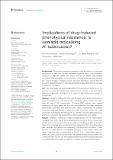Files in this item
Implications of drug-induced phenotypical resistance : is isoniazid radicalizing M. tuberculosis?
Item metadata
| dc.contributor.author | Hammond, Robert | |
| dc.contributor.author | Kloprogge, Frank | |
| dc.contributor.author | Della Pasqua, O. | |
| dc.contributor.author | Gillespie, Stephen Henry | |
| dc.date.accessioned | 2022-09-09T08:30:19Z | |
| dc.date.available | 2022-09-09T08:30:19Z | |
| dc.date.issued | 2022-09-09 | |
| dc.identifier | 280558935 | |
| dc.identifier | 4b09af52-0887-432c-bb25-7cd2f701599b | |
| dc.identifier.citation | Hammond , R , Kloprogge , F , Della Pasqua , O & Gillespie , S H 2022 , ' Implications of drug-induced phenotypical resistance : is isoniazid radicalizing M. tuberculosis ? ' , Frontiers in Antibiotics , vol. 1 , 928365 . https://doi.org/10.3389/frabi.2022.928365 | en |
| dc.identifier.other | ORCID: /0000-0001-6537-7712/work/118800051 | |
| dc.identifier.other | ORCID: /0000-0003-3664-3641/work/157140941 | |
| dc.identifier.uri | https://hdl.handle.net/10023/25980 | |
| dc.description | Funding: This study was funded by a grant from the British Society for Antimicrobial Chemotherapy (GA2015-172R). | en |
| dc.description.abstract | Background: Treatment duration is long and does not guarantee eradication of infection. Shorter treatment regimens are a critical research objective to improve uptake and reduce the risk of relapse and bacterial resistance. The explanation for the need to continue treatment after patients are culture negative remains elusive. We have previously shown that the presence of lipid inclusions in mycobacterial cells is associated with an increase in antibiotic resistance. Aim: We investigate the bactericidal effect of isoniazid and rifampicin and the expression of lipid inclusions and the associated phenotypic antibiotic resistance to a range of anti-tuberculosis agents in current use. Methods: Antibiotic killing effect for both M. tuberculosis and M. komossense were investigated by both hollow fiber bioreactor (HFS) studies and static time kill curve (STKC) experiments. Following STKC cultures were stained with resazurin, Sytox green and Nile red to establish their live/dead (resazurin positive/Sytox positive) and lipid inclusion status respectively. In addition, M. komossense was studied in the hollow fiber bioreactor model (HFS) and exposed to isoniazid (H) and rifampicin (R). The MIC of current antituberculosis agents for cells from the treated hollow fiber experiments were tested. Results: Antibiotic killing was similar for both species. For M. komossense; isoniazid was ineffective at the established MIC (1mg/L) in the hollow fiber bioreactor but rifampicin reduced the viable count rapidly at MIC (0.4mg/L). When the two drugs were combined at their respective MICs the killing effect was significant and greater than separately. Cells exposed to isoniazid (1x & 9x MIC) for 168 hours showed considerable numbers of recoverable viable cells when compared with a combination of 1x MIC R & H where there were no viable cells detectable. For both drugs the number of lipid body positive cells increased over time and this effect was most pronounced for isoniazid and was associated with phenotypic resistance to multiple anti-tuberculosis drugs. Conclusion: Our results showed that isoniazid is a potent stimulator of lipid body accumulation, culture persistence, and phenotypic resistance to multiple anti-tuberculosis drugs. These findings emphasise the importance of understanding mechanisms of drug-drug interactions and phenotypic resistance in regimen building. | |
| dc.format.extent | 12 | |
| dc.format.extent | 2790584 | |
| dc.language.iso | eng | |
| dc.relation.ispartof | Frontiers in Antibiotics | en |
| dc.subject | Tuberculosis | en |
| dc.subject | Antibiotic resistance | en |
| dc.subject | Dormancy | en |
| dc.subject | Phenotypic resistance | en |
| dc.subject | Drug development | en |
| dc.subject | RM Therapeutics. Pharmacology | en |
| dc.subject | NDAS | en |
| dc.subject | SDG 3 - Good Health and Well-being | en |
| dc.subject.lcc | RM | en |
| dc.title | Implications of drug-induced phenotypical resistance : is isoniazid radicalizing M. tuberculosis? | en |
| dc.type | Journal article | en |
| dc.contributor.institution | University of St Andrews. Sir James Mackenzie Institute for Early Diagnosis | en |
| dc.contributor.institution | University of St Andrews. Centre for Biophotonics | en |
| dc.contributor.institution | University of St Andrews. Infection and Global Health Division | en |
| dc.contributor.institution | University of St Andrews. Global Health Implementation Group | en |
| dc.contributor.institution | University of St Andrews. Gillespie Group | en |
| dc.contributor.institution | University of St Andrews. Biomedical Sciences Research Complex | en |
| dc.contributor.institution | University of St Andrews. School of Medicine | en |
| dc.identifier.doi | 10.3389/frabi.2022.928365 | |
| dc.description.status | Peer reviewed | en |
| dc.identifier.url | https://www.frontiersin.org/articles/10.3389/frabi.2022.928365/full?utm_source=F-NTF&utm_medium=EMLX&utm_campaign=PRD_FEOPS_20170000_ARTICLE | en |
This item appears in the following Collection(s)
Items in the St Andrews Research Repository are protected by copyright, with all rights reserved, unless otherwise indicated.

